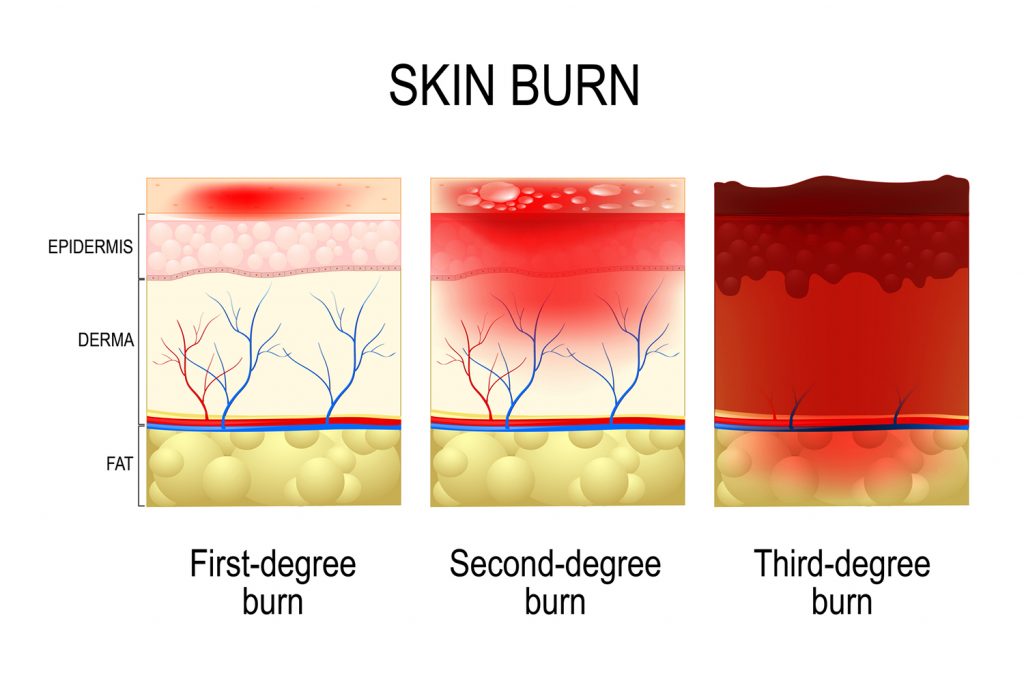Do You Know the 4 Degrees of Burns?
You’re no doubt familiar with 1st-degree burns – that is, the kind of burn caused by hot steam from a boiling pot of water, a sunburn, or getting your hands too close to the campfire for a moment. These superficial burns only affect the outer layer of the skin, called the epidermis, causing soreness, sometimes mild pain, and reddening of the skin.
Second-degree, third-degree and fourth-degree burns are considerably more serious.
A 2nd-degree burn, known as a partial thickness burn, damages the epidermis and the lower layer of skin, the dermis. Second-degree burns cause pain, redness, swelling, peeling skin, and blisters which are sore to the touch. The burn area may also look shiny and wet. If you have a superficial 2nd-degree burn, only part of your dermis is damaged and the burn should not leave a scar. If you have a deep partial thickness burn, more of the dermis layer is damaged and you may have a scar and permanent discoloration of the burn site.
Third-degree burns, known as full thickness burns, destroy both layers of skin, which may appear black, brown, white or yellow. No pain or soreness is experienced at the burn site because nerve endings are damaged. The patient may experience Shock – exhibit pale and clammy skin, bluish lips, become weak and less alert.
A 4th-degree burn is potentially life-threatening, as besides destroying skin, the burn also affects bones, muscles, and tendons and may cause Shock. The burn site may appear white or charred. Ironically, the patient experiences intense pain from the treatment of the burn, not the burn itself, where nerve endings have been killed.
The pain from 3rd and 4th-degree burns can be quite intense and last a long time. It’s difficult to control due to its changing patterns and unique characteristics. The Pain is particularly pronounced when the burn is treated and the dressings changed.
The causes of burns are classified as:
- Thermal burns, caused by sources of wet or dry heat such as flames, steam, hot metals or scalding liquids.
- Chemical burns caused by acids, alkalies, detergents, or solvents which contact the skin or eyes.
- Electrical burns from AC or DC electrical current.
- Radiation burns caused by ultraviolet sunlight or radiation sources such as X-Rays.
How to Treat a Burn
First aid for all degrees of burns has been revolutionized with the advent of hydrogels, introduced in the early 1980s. Hydrogels have saved many lives and alleviated much pain and suffering.
Before hydrogels, there were two well-developed protocols for treating serious burns, know as wet or dry. Some medical professionals insisted on the dry protocol, i.e. put nothing on a serious burn. Others went with the wet protocol, where the burn was covered with a sterile burn sheet and then irrigated with sterile saline solution. Both of these protocols have serious limitations.
Chris Westwood, owner of First Aid Supplies Online and former Army Medic says, “Thankfully we have hydrogels now and First Aid Supplies Online is a proud distributor of Burn Free burn care products. The preferred treatment by professionals for all burns today is hydrogel. Whether administered topically as a free-flowing gel or in a sterile burn dressing impregnated with hydrogel. You can use hydrogel on any size, type, and degree of burn for startling and effective results.
“The reason hydrogels are so effective is that they are 99.999% water and act as a heat transfer – literally pulling the heat out of a burn and stopping what’s know as burn progression.”
There are plenty of burn remedies out there: salves, ointments, and sprays. These old school remedies are still helpful on minor 1st-degree burns, but harmful to any other. It’s best to stick with a hydrogel to treat any burn of any degree.
See all of our burn treatment first aid products.

